- Working at KSC
- NASA Old Headquarters building on KSC destroyed.
- Flintknapping points
- Vampires of Kennedy Space Center and the O&C
- Demons of Kennedy Space Center
- Demons of Kennedy Space Center, corpus callosotomy
- Ghosts of Kennedy Space Center, End of Spiders
- Dreams of Kennedy Space Center, lovers and pyramids.
- Witches of Kennedy Space Center
- Cave Bears of Kennedy Space Center
- Aliens of Kennedy Space Center, uninvited guests
- Remembering Kennedy Space Center
- Lake 33 Killing Relic
Hernando de Soto Expedition as art
Hernando de Soto?
Before I started writing Freedom's Quest;
-(I never had any plans on writing) Just love to read history.
On the internet of course, I came across the translation of "A Gentleman of Elvas" one of the four or five eye witness accounts of the Spanish Invasion of Florida and the southeastern United States.
Everything north of Mexico was then called Florida.
As a history geek, of course I could not resist reading the journal during my lunch breaks. Then studying maps and towns of then and now and trying to recognize the names of the Native Americans encountered by the invaders.
A few problems hindered me in that endeavor. First the Spanish-English translations. Second, and more important, the years following the European invasions of the new world witnessed migrations, diseases and the re-forming the nations and towns into newer cultures composed of people with a better tolerance to European diseases.
In Short, names, clans and genetic make up changed even before the arrival of colonists.
A note on most of the art I have added. The drawings or wood cut prints come directly out of the Library of Congress 'with no known restrictions on reproduction'
Note on the arrangement: I chose to tell a story using the images and consequently they are not all in chronological order.
Something caught my eye. Something that disturbed me for along time. Something that I told people about who pretended to be interested.
Something caught my eye. Something that disturbed me for along time. Something that I told people about who pretended to be interested.
It wasn't that De Soto brought 500 sets of chains to Florida and Chained everyone he could to carry the expeditions baggage.
No it was description of the chained Indians when they had to cross a swamp. In hip or knee deep muck they would roil the water with their chains and make the gar or mud-fish. rise to the surface and the Indians would eat them raw standing in the muck.
For days, perhaps weeks that description bothered me until at last it dawned upon me. The invaders could not feed the captives carrying the army's baggage!
Then I thought, wait, nearly a 1000 soldiers, 200 horses, cattle and hogs. Add in 500 captives and any native scouts, guides.
How did they manage to feed everyone?
And the realization that they were not able to feed everyone.

Have to love the fantasy art that the natives of North America welcome nearly a thousand soldiers with open arms as portrayed above.

A sign at the stunningly beautiful Ichetucknee Springs, suggesting something evil may have happened.
In the school books, the De Soto expedition was put in the category of "Brave Explorers."
However upon reading the eye witness accounts of the expedition, and the brutal chaining of 500 native Americans to carry the expeditions baggage, it can only be defined as evil.

Everything north of Mexico was then called Florida.

The Grand Expedition leaving Spain

Arrival!
https://www.loc.gov/resource/cph.3c04323/
Title
"The
caravels had arrived"
Summary
Juan
d'Añasco with soldiers in a rowboat after arriving in the bay of
Apalache, caravels in background.
Contributor
Names
Gibbs,
George, 1870-1942, artist

Unloading the ships. Seeking the Florida Gold

"Tampa Bay"
My favorite of all the drawings.
Unlike the other landing drawing, I would guess the artist who made this Tampa drawing actually visited Tampa Bay and captured the afternoon storms that often make Tampa the lightning capital of the world.
Title
De
Soto -- Tampa Bay, Florida--1539 / Drawn by Capt. S. Eastman, U.S.A.
; Engraved by James Smillie.
Summary
Print
shows Hernando De Soto and other soldiers at Tampa Bay.
Contributor
Names
Smillie,
James, 1807-1885, engraver
Eastman,
Seth, 1808-1875, artist
Created
/ Published
1853.
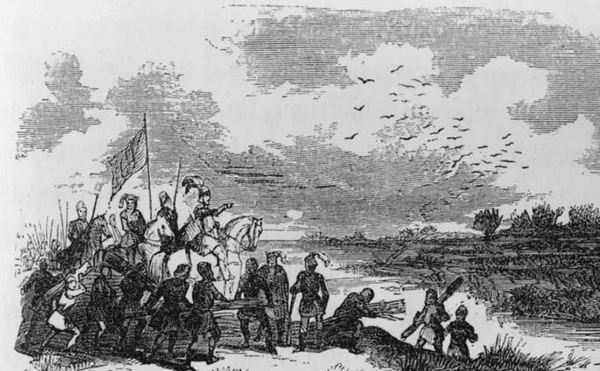
"The Long Swamp"
Welcome to Florida

"What the Hell?" (those are my words.)
Florida after 500 years is still difficult to push through.
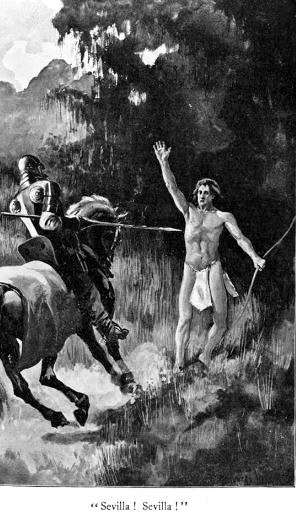
Title "Sevilla! Sevilla! / George Gibbs. Summary Spaniard dressed in loincloth signalling to Alvaro Nieto, a lancer on horseback about to charge. Contributor Names Gibbs, George, 1870-1942, artist
The discovery of a Spaniard who had lived with the Florida Indians. De Soto now had a translator!
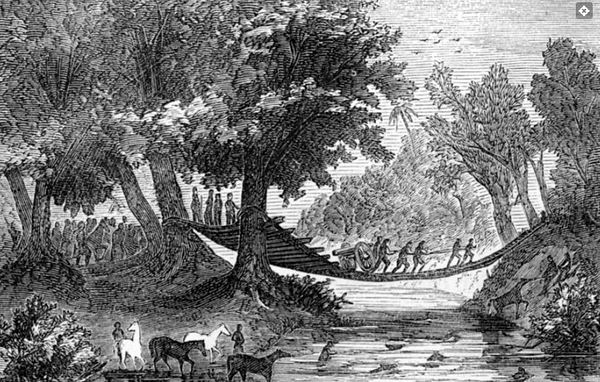
Swimming the horses across a river. No gold yet.
Orr,
J. W. (1858) Crossing
on an Indian bridge / J.W. Orr, N.Y.
Florida, 1858. [Published] [Photograph] Retrieved from the Library of
Congress, https://www.loc.gov/item/91794198/.

Meeting between strangers
Title
De
Soto and Vitachuco / George Gibbs.
Summary
Vitachuco,
an Indian leader in Florida, speaking to Hernando de Soto with
Indians and Spaniards gathered around them.
Contributor
Names
Gibbs,
George, 1870-1942, artist

Discovery of the remains of the Narvaez expedition.
Four people of the expedition completed the trip to Mexico.
Orr,
J. W. (1858) Remains
of the party of Narvaez / J.W. Orr, N.Y.
Florida, 1858. [Published] [Photograph] Retrieved from the Library of
Congress, https://www.loc.gov/item/91789831/.

Title "Back and forth they charged" / George Gibbs. Summary Spaniards, with swords and lances, on horseback attacking Indians during the Battle of Mauvila. Contributor Names Gibbs, George, 1870-1942, artist
Native Americans war on the invaders

Wary of the invaders
Title
[De
Quelle maniere Tascaluça reçut General]
Summary
The
manner in which Toscaluça received the General.
Created
/ Published
[published
1731]
https://www.loc.gov/resource/cph.3c04343/

Your Gold.....and corn
Interesting drawing. The vast army approaches from over the ridge.
Title
[Découverte
d'une trahison dans Mauvila]
Summary
Discovery
of treachery in Mauvila.
Created
/ Published
[published
1731]
https://www.loc.gov/resource/cph.3c04344/
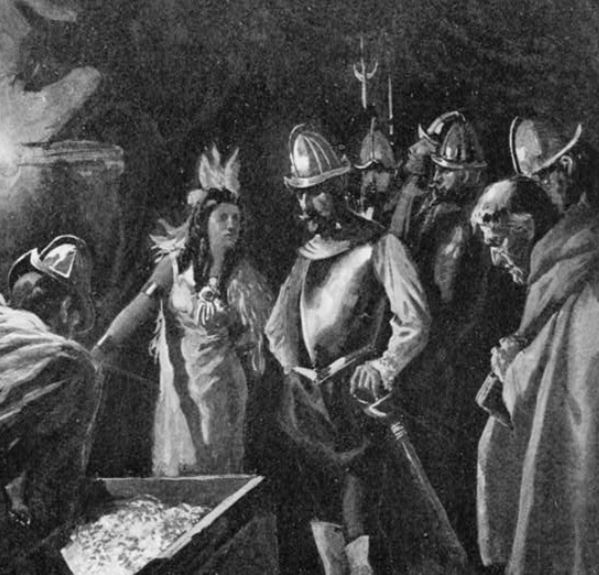
Attempts to Bribe De Soto with freshwater pearls.
Title
The
Lady of Cofachiqui / George Gibbs.
Summary
The
Lady of Cofachiqui, chief of her village, showing Hernando de Soto
and his soldiers contents in treasure chest.
Contributor
Names
Gibbs,
George, 1870-1942, artist
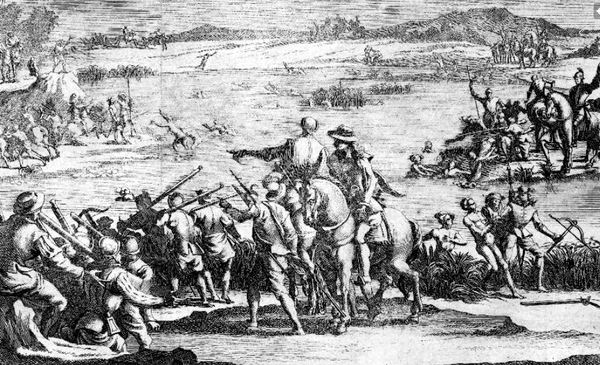
War around the pond
Title
[Resolution
des Indiens, & leur fortir de l'étang]
Summary
Resolution
of the Indians and their coming out of the pond.
Created
/ Published
[published
1731]

One of the few drawings that shows a captive carrying a back breaking load (a deer)
Until I read the journal, I had no idea Soto used 500 native American slaves to carry the expedition's supplies.

War in the vast land known as Florida.
Steel and horses against flint and chert
Title
[Entrée
de Espagnols dans la Province de Chicaça]
Summary
Entry
of the Spanish into the Province of Chicaça.
Created
/ Published
[published
1731]

One of my favorite drawings, only because it hints at how many people, soldiers, slaves and freeborn herdsmen who were part of the trek across the Southeastern United States
How did they feed everyone?

Natives burn their own village at the approach of Soto's armies

Natives attempting to ambush the Invaders by swimming through the water lillies

Wrong???
The Library of Congress has this tagged as a the De Soto Expedition, invasion. I think this might be a mistake because the stalking natives are carrying guns and the Europeans are dressed more like soldiers of the Seminole Wars. Or the artist envisioned the De Soto expedition with the incorrect weapons and clothing.
Title
[Indians
stalking Spaniards riding horses in swamp]
Created
/ Published
[published
1873]
has
to be wrong
Wm.
McCrea & Co., Stereotypers, Newburgh, N.Y.
-
Illus. in: Ferdinand De Soto, the discoverer of the Mississippi / by
John S.C. Abbott. New York : Dodd & Mead, 1873

This may be a drawing of the disaster at Mabilla.
The fight at the fortress of Mabila in the country of the Alabamas:
“The Indians fought with so great of spirit that they, many times, drove our people back out of the town. The struggle lasted so long that many Christians, weary and very thirsty, went to drink at a pond nearby, tinged with the blood of the killed, and returned to the combat."
"breaking in upon the Indians and beating them down, they fled out of the place, the cavalry and infantry driving them back through the gates, where losing the hope of escape, they fought valiantly; and the Christians getting among them with cutlasses, they found themselves met on all sides by their strokes, when many, dashing headlong into the flaming houses, were smothered, and, heaped one upon another, burned to death….”
"They who perished inside the walls, there were in all two thousand five hundred, a few more or less. Upwards of five thousand bodies lay outside on the plain. Of the Christians there fell two hundred... Of the living, one hundred and fifty Christians had received seven hundred wounds..."
--- Journal of Elvas

The drawing in my school books as a child.
De Soto "Discovering" the Mississippi River
No sign of the 500 chained men and women carrying baggage, or the 200 women captured at Maubilla, to sell in Mexico.

Death of De Soto
Death
of the Adelantado b&w
film copy neg.
Illus.
in: De Soto and his men in the land of Florida / Grace Elizabeth
King. New York : The Macmillan Company, 1898, facing p. 250.
-
Reproduction of illustration by George Gibbs.
Return Home from Hernando de Soto page

My newest book, available on Amazon
(paperback and e-book)
For pet lovers around the globe, "It's a Matter of Luck" is a collection of heart warming stories of horse rescues from the slaughterhouse.
Available on Amazon

It's a Matter of Luck: Inspirational, Heartfelt Stories of Horses Given a Second Chance.
by Kim Ryba & Lina T. Lindgren
Warning: This book may cause your eyes to water in a good way. (speaking from experience after reading it)
Please give Kim and Lina a heartfelt review on Amazon!

Author Bruce Ryba at Kennedy Space Center Launch Pad 39B & Artemis 1. "We are going to the Moon!"
Author's discussion (that's me) on You Tube of a book review on Amazon
For the video versions of information, please check out my YouTube Channel (Turkeys, Flintknapping, dive stories etc.)

My fictional series/stories on Florida history:
Freedoms Quest (book one)
Struggle for the northern frontier and other lost tales of old Florida.
Available on Amazon

Desperate times call for bold action.
In a desperate move to retain Florida and protect the treasure-laden galleons on their dangerous return journey to Europe, the King of Spain issues a royal decree offering refuge to all English slaves who escape Florida and pick up a musket to defend the coquina walls of Saint Augustine.
In another bold gamble, the King offers refuge to the dissatisfied Indian nations of the southeast who will take up arms against the English.
Clans, traumatized by war and disease, cross the Spanish Frontier to settle the cattle-rich land and burned missions of Florida.
Follow the descendants of the conquistador Louis Castillo in remote Spanish Florida, a wild and swept by diseases, hurricanes, and northern invasions.
Book Two: Available on Amazon!